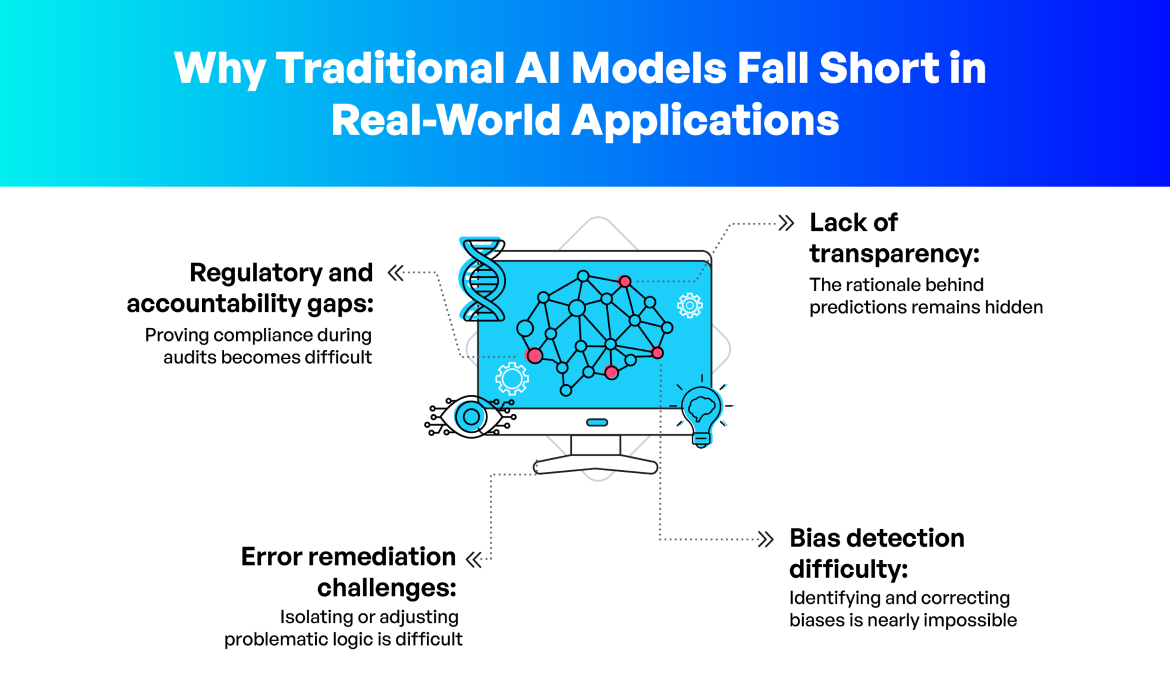
The world of AI requires not only smart algorithms but the ability to justify them in the business context. The need to have explainable AI has stopped being a technical choice as industries change. It is now a strategic requirement. Opaque decisions are suspicious, whether in the form of a medical diagnosis or credit approval. Explainable AI (XAI) in industries comes in handy there, serving as clarity, accountability, and confidence. This article discusses the importance of AI transparency in industries that want trust, compliance, and long-term impact of AI.
In high-stakes critical environments, explainable AI will be forced to address the limitations of the conventional black-box systems. Such opaque models generate outputs without indicating the logic behind them, and this significantly hampers auditability and trust in their decisions.

The traditional AI models fail due to the following reasons:
A recent survey indicates that only 28% of consumers trust organizations to use AI responsibly, which is evidence of a general lack of confidence in opaque AI models.
Explainable AI (XAI) has become a critical element in the optimization of decision-making processes in the dynamic environment of contemporary industries. In contrast to the traditional black-box models, XAI provides transparency, which allows the stakeholders to understand how the AI-based models generate their decisions.
The most important advantages of XAI in decision-making:
Applications Across Industries:
XAI in industries is crucial in such fields as finance, healthcare, insurance, and aviation, where the decisions made may affect people and community safety to a large extent. Regulation systems like the AI Act in the EU and the Equal Credit Opportunity Act in the U.S. require profound AI transparency in high-risk AI systems.
Firms engaged in such controlled activities are required to provide extensive technical records, model risk reports, and decision rationales. According to GDPR and other compliance measures, companies must ensure that they have meaningful human control and traceability in automated decision-making. As an example, in order to explain adverse decisions, even when based on a complex model, financial institutions using AI in credit scoring must adopt explainability tools such as SHAP or LIME.
Key benefits of adopting explainable AI in regulated industries:
In every sector under regulatory scrutiny, explainable AI not only creates power systems but also transparent, auditable, and accountable systems, which makes the transparency of AI a must-have and not a desirable characteristic.
In the modern environment, open communication on the use of AI will either ruin or save the customer-brand relationship. It has been reported that 78% of the general population wants organizations to be open on how their AI systems work, including data sources, training systems, and decision logic. The transparency of AI establishes trust and makes the organizations reliable leaders.
Why transparency matters:
Building Customer Trust Through AI Transparency:
Besides, 63% of customers are worried about bias or unfairness in AI outputs and proving that these aspects are transparent will directly solve trust concerns.
The combination of narrative with visual elements or simple bullet descriptions is a good way of covering the distance between the technical detail and customer comprehension. Instead of using scripted messaging, employ the mix-and-match formats: short paragraphs highlighting the outcomes of transparency, and then bullet points with actionable evidence or examples.
Explainability is not only a marketing term; it is an essential component of governance and risk management framework. The increased standards and expectations of stakeholders in regulated industries have necessitated the strategic need for explainable AI.
Why Governance Demands Explainability
Guidelines by NIST and other organizations argue that institutions should control AI systems through well-planned supervision, ongoing risk assessment, and complete traceability. Through recording model assumptions and decision flows, teams are able to audit systems efficiently and prevent opaque and muddy black-box risk. Stanford AI Index Report 2023 showed that 65% of organizations cite lack of explainability as their major adoption challenge.
Real Impact: Risk Metrics and Compliance Benefits
An analysis of 450 decision instances in 15 international companies provided that the implementation of XAI resulted in a 32% change in strategic fit and a 25% decrease in operational risk. McKinsey echoes these gains: when explainable systems are integrated into business, it is more likely to notice bias or drift more quickly, thus minimizing reputational and operational losses.
Important Elements of Risk-Resilient Government
Explainable AI is an important facilitator of trust, accountability, and performance in the present AI-driven economy. From regulated sectors to consumer-facing services, XAI in industries bridges the gap between technical complexity and real-world understanding. It reinforces model governance, minimizes compliance risks, and enables cross-functional teams to make good decisions. The need to explain is no longer a choice; it is an operational requirement since 60% of businesses are already using AI transparency as a priority in their adoption strategy.